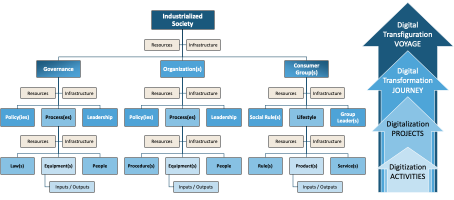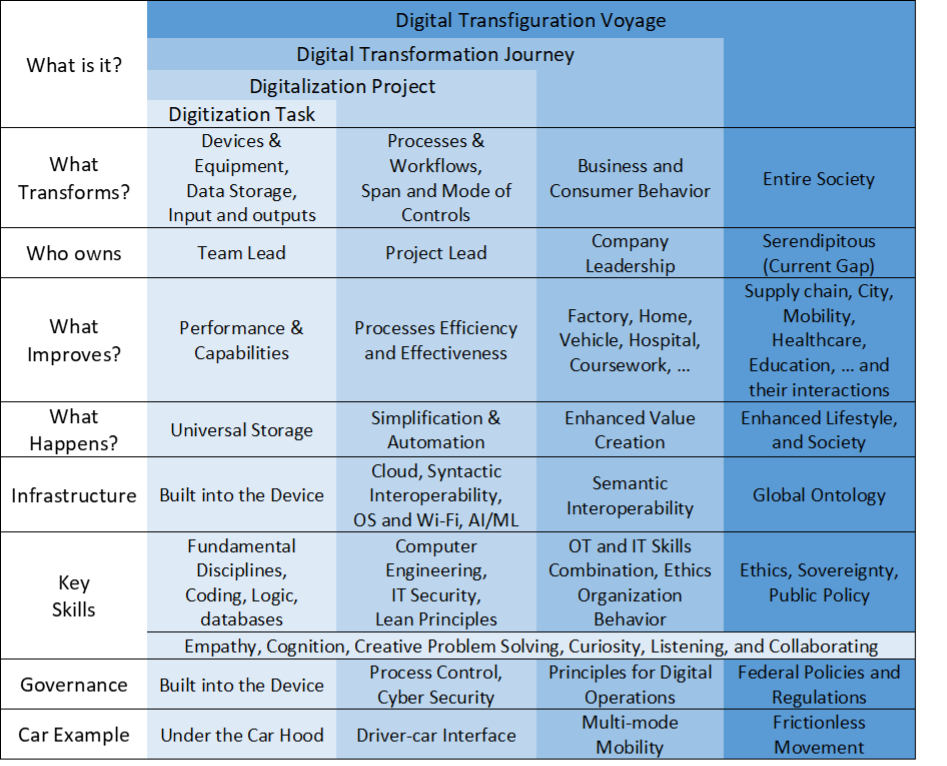A Comprehensive Model of Digital Transformation and the Next Logical Level
1. Introduction
The Fourth Industrial Revolution provides an opportunity to meaningfully serve society. Popular definitions of Digital Transformation have come from management consulting firms with little consideration of social impact (the why). Several review papers {Cited in DISO} reveal a void: how to structure and view digital transformation in sync with changes in social norms? Authors used design thinking to comprehensively view the industrialized ecosystem covering value creation, value consumption, infrastructure, skills, and governance. The model unifies digital penetration to align stakeholders on their transformation journey, revealing the next logical step: Digital Transfiguration.
This publication is based on a paper published by the scientific journal Digital Society: https://doi.org/10.1007/s44206-023-00084-w
2. Portrait of a Transformation
Let’s recap history. In August 1888, Bertha Benz drove a Benz Motorwagen Model-3 for 106 km in Germany, to prove value of a ‘horseless carriage’. She solved several problems along the way – fuel, mandatory repairs, seeking directions, and what not. That was the beginning of a revolution in transportation and look how far we have come since then! We have built infrastructure (roads, gas stations, workshops); added governance (laws, licenses, registration); and developed skills (manufacturing, maintenance, driving). Transformation takes a lot more than a few innovations. In fact, changes to infrastructure in turn impacts product and system innovations. This mutual dependence of product and infrastructure evolution creates a new ecosystem. That is transformation; where even Carl and Bertha will not recognize what they started. It’s a long-drawn process, with no clear end.
3. Digital Transformation Today
Digital Transformation involves the integration of digital technologies into various aspects of an organization to fundamentally transform value creation. What about digital consumption and delivery? The complexity, ambiguity, and inter-dependencies preclude people from clearly seeing the digital ecosystem of tomorrow. Just like the Benz family could not have seen the automotive industry of today, we may not be able to see the driver-less mobility of tomorrow fueled by AI. A similar lack of clarity exists in every other sector we know of. Thus, we need a North Star – a guiding framework, in the absence of a clear destination.
4. Industrialized Society – A Unified Model
In today’s ecosystem, organizations create value with discipline and structure. Managers leverage available resources, skills, and infrastructure; comply with rules and regulations; and deliver valuable products/services to consumers. The figure below is a conceptual model of the ecosystem of our industrialized society, born during the first revolution, and matured during the second revolution. Digital penetration is now making it increasingly more effective and efficient.
This ecosystem consists of various consumer groups, organizations, as well as governing bodies. The flow of value requires infrastructure and resources. For an organization to create value, several processes are required, which are controlled through compliance with organizational policies, the use of company infrastructure, within resource limitations. To execute various processes, people use equipment/devices as per standard operating procedures, consume energy and raw materials, and leverage facilities and logistics infrastructure. There is a similar hierarchical structure for the governance vertical as well, requiring no additional description.
Consumer groups share certain lifestyle(s), which are governed by social views/rules and are directed by group leaders. To enjoy the lifestyle, the interest groups depend on infrastructure that is either available publicly or through associations. Individuals use products/services as per family rules, consume energy and other resources, and leverage their private infrastructure. This model fits well across multiple sectors, since it gets down to the basics of value creation, value consumption, and the governance of value transfer.
Coming back to the example of automobile sector – car manufacturers use various processes to design, build, sell, and service cars. Those cars are either sold to other companies (B2B) and used as equipment or they are sold to individuals (B2C) and used as products. The government provides governance through the transportation department and state laws around driving regulations. All this uses the transportation infrastructure.

5. Digital Penetration of the Industrialized Society
The digital penetration started with the adoption of digital equipment (Digitization), to digital processes (Digitalization), to processes integration at the value creation level (Digital Transformation), all the way to having the entire creation-consumption value cycle as digital, creating meaningful consumer experience (Now defined as Digital Transfiguration).
Digitization is the core of the third industrial revolution. Enhanced digitalization and digital transformation are key to the fourth industrial revolution, and digital transfiguration is what provides purpose to the fourth revolution. This is graphically depicted above.
Digitization can be seen as the digital transformation of equipment. And digital transfiguration can be seen as the digitization of the ecosystem. Either way, digital is the transforming catalyst in the process that changes something else. It is also clear that technological innovations are at the bottom and the resulting revolution of our society is at the top. This sustained change through various stages is not to be confused with rapid continuous improvement within a stage. It needs to be viewed as creating new value propositions not previously possible, in addition to making existing systems better.
The figure below further describes these stages.

6. Taxonomy:
With this understanding, we can now define the terms consistently:
- Digital – Something using discrete digits. Often string of binary numbers (0s and 1s) to represent an analog signal, message, picture, instructions, and program.
- Digitization – Changes to value-creating devices or equipment, enabled by digital storage, for the universality of application.
- Digitalization – Changes to an isolated process, enabled by digitization of devices, equipment, and human-machine interface, for simplification or automation.
- Digital Transformation – Changes in value creation or consumption, through the integration of digitalized processes and digitized devices, for enhanced business value and consumer experience.
- Digital Transfiguration – Changes in industrialized society, from massive integration of all digitally transformed entities in the ecosystem, to enable the human pursuit of self-actualization.
7. Outlook
The unified digital penetration model presented here shows that digital transformation is not a definable destination, and it is also not about technology. It is about humans, actions, behavior, and values. Technology is merely a catalyst that must be carefully adopted for a meaningful change, that we may not be able to see clearly.
Just like in the early 19th century, different people had different views of what horseless carriages (cars) would be; Today it is difficult to predict how mobility will look in 50 years. But it will be radically different, with entirely new infrastructure, businesses, and governance. Imagine: personal autonomous drones, off-ground hoverboards, self-regulating rail-road systems, or a life-like metaverse. A courageous Bertha Benz of the 2030s is being watched live, flying in a personal drone across the Sahara Desert, to prove a point. Similar could be the case for changes in other sectors, and the eventual collapse of domains into a new configuration of our lifestyle.
About the authors
This article was written by Johannes Vrana, CEO and Consultant @ Vrana GmbH and Ripi Singh, Chief Innovation and Strategy @ InspiringNex.



